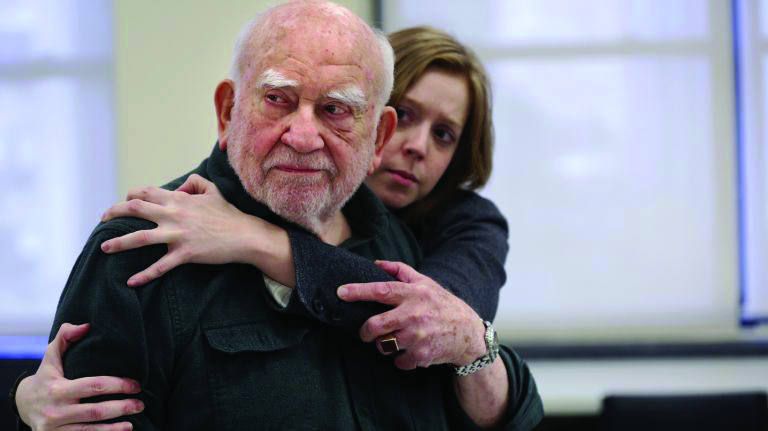Students, faculty and members of the community gathered in The Helene Fortunoff Theater in the Monroe Lecture Hall on Thursday night to watch a performance of the spoken-word play “The Soap Myth.”
The play, written by Jeff Cohen, featured performances by Ed Asner, an Emmy-award winning actor from “The Mary Tyler Moore Show,” and Johanna Day, a Tony-nominated actress for her roles in “Sweat” and “Proof.” The show at Hofstra was the final stop on a two-week East Coast tour.
The story revolves around a rumor from World War II that Nazis used fat from Jewish victims of the Holocaust to make soap. It first ran Off-Broadway in 2012, but it seems even more poignant now as hate groups grow and make headlines.
“When anti-Semitism reared its ugly head earlier this year, I have to admit, we were unprepared as a community,” said Rabbi Dave Siegel, the executive director of Hofstra Hillel.
Asner played Milton Saltzman, a Holocaust survivor desperately trying to get an exhibition installed at a Holocaust memorial museum about the soap made by Nazis. Asner received great praise and applause for his performance during the talkback after the show. His addition to the cast was also a major draw for some people.
“I saw it online, by accident, and I saw Ed Asner, and I was like, he’s eighty-eight years old, I probably won’t see him again after this,” said Cole Schmidt, a senior film studies and production major. “It’s a small, remote opportunity, so I had to jump on it.”
Saltzman’s story is covered in the play by the character Annie Blumberg, a journalist with a few years of experience who writes for a Jewish magazine. Her investigation brings her in contact with Saltzman himself, historians at the memorial museum and a popular Holocaust denier. As a young Jewish woman, Blumberg’s experiences with each person add to her own story and increase her personal investment in Saltzman’s.
Transcripts from one of the Nuremberg trials that included testimony from a Russian prosecutor and a lab assistant who had the “recipe” to the make the soap were also read aloud.
“I’ve heard about how they did experiments, but I’ve never heard it in detail,” said Olivia Haas, a first year radio production studies major. “I’ve never actually heard stories about it.”
“For me, at least, it adds a new level to what these people suffered and what they went through,” Schmidt said. “It’s worth knowing.”
The story sheds light on tension between Holocaust survivors as eyewitnesses, and historians who need hard evidence to declare something a fact.
Saltzman has a picture from 1946 that shows people burying a casket with soap in it and he speaks about seeing the soap itself at a concentration camp. However, historians have not found paper trails that indicate a mass production and distribution of the soap, deeming it a “myth”.
“The play is not about soap,” said Cohen during the talkback.
It is about Saltzman and those he represents who, as stated in the play and during the talkback, are the history. It is about eyewitness accounts versus documentation and hard evidence, and the compromises that can be found so people like Saltzman can still talk about what they saw.







